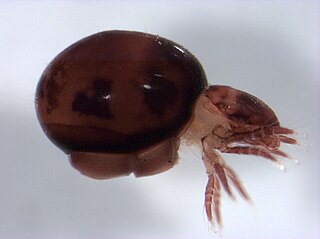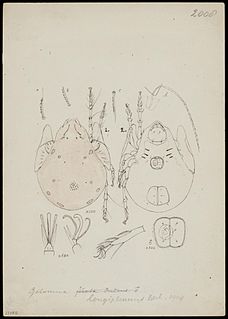
Xysticus is a genus of ground crab spiders described by C. L. Koch in 1835, belonging to the order Araneae, family Thomisidae. The genus name is derived from the Ancient Greek root xyst, meaning "scraped, scraper".

Attulus is a genus of jumping spiders that was first described by Eugène Louis Simon in 1889. The name is a diminutive form of a common prefix for salticid genera, -attus.

Ozyptila is a genus of crab spiders that was first described by Eugène Louis Simon in 1864. It has been misspelled as "Oxyptila" in multiple accounts.

Zicman Feider (1903–1979) was a Jewish Romanian acarologist, a remarkable researcher and a gifted academic, whose work continues to influence by many generations of biologists, some of whom studied zoology under his supervision. His name as a researcher is forever associated with the enigmatic group of Acari a.k.a. Acarina, for which he arduously worked to perfect their taxonomy. Alone or in collaboration with his numerous disciples, he described and created 1 phalanx and 2 sub-phalanxes, 16 families and 8 subfamilies, 40 genera, 4 subgenera, and 145 species new to science. One could only compare professor Feider’s work with that of Aristide Caradgea, who studied micro-Lepidoptera, attracting all the world researchers of that group to come in a pilgrimage to his modest place in Grumazesti, Neamț, Romania. Similarly, Feider’s strenuous line of work encompassed Acari collections from all over Europe, St. Helen Island, North Korea, Nepal, Mongolia, India, Vietnam, Brazil, Venezuela, and Chile, making his lab in the Alexandru Ioan Cuza University, of Iași, Romania, a Mecca of the world’s acarologists.

Oribatida, also known as oribatid mites, moss mites or beetle mites, are an order of mites, in the "chewing Acariformes" clade Sarcoptiformes. They range in size from 0.2 to 1.4 millimetres. There are currently 12,000 species that have been identified, but researchers estimate that there may anywhere from 60,000 to 120,000 total species. Oribatid mites are by far the most prevalent of all arthropods in forest soils, and are essential for breaking down organic detritus and distributing fungi.

Trombidiidae, also known as red velvet mites, true velvet mites, or rain bugs, are small arachnids found in plant litter and are known for their bright red color.

The Laelapidae are a family of mites in the order Mesostigmata. The family is also referred to in the literature as Laelaptidae, which may be the correct spelling.
Cheiroseius is a genus of mites in the family Ascidae.
Dinychidae is a family of mites in the order Mesostigmata.

Gnaphosa is a genus of ground spiders that was first described by Pierre André Latreille in 1804. They all have a serrated keel on the retromargin of each chelicera.

Trachyzelotes is a genus of ground spiders that was first described by H. Lohmander in 1944 as a subgenus of Zelotes, and was raised to genus status in 1967. It has a body length of 3 to 13 millimetres.

Galumna is a genus of mite in the family Galumnidae.












